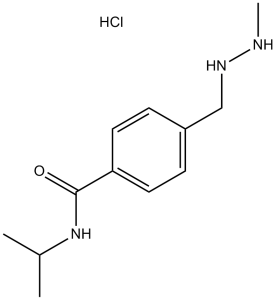This product is for research use only, not for human use. We do not sell to patients.

| Size | Price | Stock |
|---|---|---|
| 50mg | $55 | 3-6 Days |
| 100mg | $80 | 3-6 Days |
| 250mg | $120 | 3-6 Days |
| 500mg | $170 | 3-6 Days |
| 1g | $245 | 3-6 Days |
| 2g | $345 | 3-6 Days |
| 5g | $545 | 3-6 Days |
Cat #: V1446 CAS #: 366-70-1 Purity ≥ 98%
Description: Procarbazine HCl (formerly NSC77213; Ro4-6467; CB-400-497; PCB; PCZ; Matulane; Natulanar), the hydrochloride salt form of procarbazine, is an anticancer chemotherapeutic medication approved for the treatment of Hodgkin's lymphoma and certain brain cancers.
Publications Citing InvivoChem Products
Product Promise

- Physicochemical and Storage Information
- Protocol
- Related Biological Data
- Stock Solution Preparation
- Quality Control Documentation
| Molecular Weight (MW) | 257.76 |
|---|---|
| Molecular Formula | C12H19N3O.HCl |
| CAS No. | 366-70-1 |
| Storage | -20℃ for 3 years in powder form |
| -80℃ for 2 years in solvent | |
| Solubility In Vitro | DMSO: <1 mg/mL |
| Water: 52 mg/mL (201.7 mM) | |
| Ethanol: 52 mg/mL (201.7 mM) | |
| Synonyms | NSC-77213 HCl; CB 400-497; NSC-77213; Ro 4-6467; CB 400497; NSC77213; Ro4-6467; CB-400-497; NSC77213; Ro4-6467; Ro 4-6467/1; Procarbazine Hydrochloride; PCB Hydrochloride; PCZ; Procarbazin. Matulane. Natulan; Natulanar; Natunalar. |
| Protocol | In Vitro | In vitro activity: Procarbazine plus Cu(II) induce piperidine-labile and formamidopyrimidine-DNA glycosylase-sensitive lesions at the 5'-ACG-3' sequence, complementary to a hotspot of the p53 gene, and the 5'-TG-3' sequence. Procarbazine causes DNA damage through non-enzymatic formation of the Cu(I)-hydroperoxo complex and methyl radicals. Procarbazine has a strong clastogenic effect in hematopoietic cells and is mutagenic in a variety organs after high dose treatment. Cell Assay: Following Procarbazine or metabolite treatment, cells are diluted to 50.000/mL in 25-cm2 culture flasks (10 mL). Every 24 h, a 0.5-mL aliquot is removed, diluted 20-fold in Hematall isotonic diluent, and the cell number determined with a Coulter Model F electronic cell counter. Counts greater than 10,000/0.5 mL are corrected for coincidence. Cells are diluted in fresh culture media when cell density exceeded 1 × 106/mL. Cultures are maintained until the aggregate cell number approached 100 × 106/mL and doubling time has returned to 12 h. Cell survival is determined using Equation A, where TD(doubling time for cells of interest) is 12 h. |
|---|---|---|
| In Vivo | Procarbazine causes significant decrease in testicular and epididymal weight and a drastic reduction in haploid cells and spermatogenic arrest, demonstrating variation among the test golden hamster. Procarbazine produces a dose-dependent potentiation of MAO A in brown adipose tissue, the elevation being more pronounced following monomethylhydrazine, with activity rising to 350% of that in control homogenates in rats. Procarbazine or monomethylhydrazine reduces metabolism of this amine by a similar degree as had been determined ex-vivo in blood vessel homogenates. Procarbazine is mutagenic, clastogenic and teratogenic in a wide range of test systems of varying complexity and a wide-spectrum carcinogen in rodents and monkeys, causing tumours of the haemopoietic system, the mammary gland, the lung and the nervous system. Procarbazine in vivo undergoes a complex series of metabolic changes that result in the generation of a number of chemically reactive species, including methylating agents and free radicals. | |
| Animal model | Rats |
| Solvent volume to be added | Mass (the weight of a compound) | |||
|---|---|---|---|---|
| Mother liquor concentration | 1mg | 5mg | 10mg | 20mg |
| 1mM | 3.8796 mL | 19.3979 mL | 38.7958 mL | 77.5916 mL |
| 5mM | 0.7759 mL | 3.8796 mL | 7.7592 mL | 15.5183 mL |
| 10mM | 0.3880 mL | 1.9398 mL | 3.8796 mL | 7.7592 mL |
| 20mM | 0.1940 mL | 0.9699 mL | 1.9398 mL | 3.8796 mL |
This equation is commonly abbreviated as: C1 V1 = C2 V2
- (1) Please be sure that the solution is clear before the addition of next solvent. Dissolution methods like vortex, ultrasound or warming and heat may be used to aid dissolving.
- (2) Be sure to add the solvent(s) in order.




































